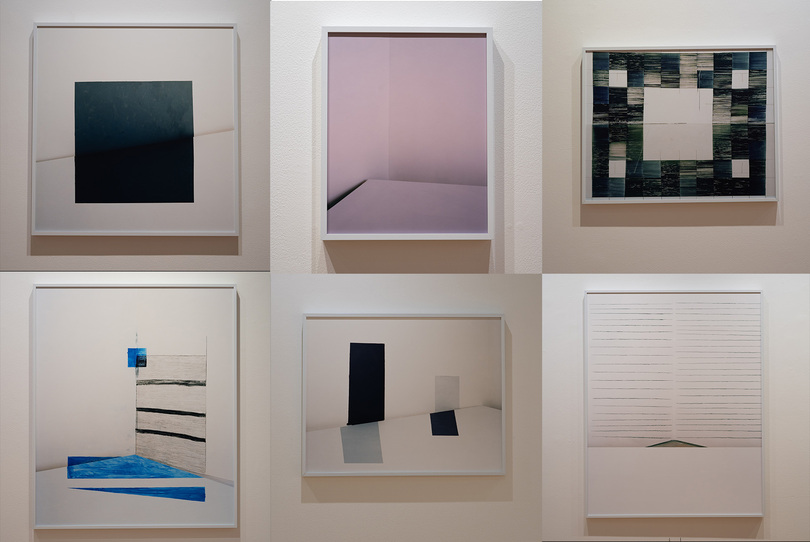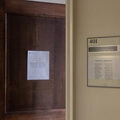Sophia Chai’s ‘Character Space’ reinterprets the Korean alphabet

Alex Zhiltsov | Contributing Photographer
Artist Sophia Chai encapsulates her Korean culture through photography. She shares her story through visual art.
Get the latest Syracuse news delivered right to your inbox.
Subscribe to our newsletter here.
Two small indigo rectangles mirror each other in Sophia Chai’s “Untitled” piece, the last of 13 photos curated for her exhibit, “Character Space.” The images are inspired by the phonetic sounds of the Korean alphabet, connecting verbal communication to shape.
“I think of the Korean alphabet like a pictorial diagram,” Chai said. “In my photographs, I try to reiterate the kind of visual space that I make when I make a sound (from the alphabet).”
Chai’s exhibit opened on Friday and will run until May 17 at Light Work, a nonprofit art facility that supports photographers through residencies and exhibitions on Syracuse University’s campus. Based out of Rochester, Minnesota, Chai currently works as an independent artist and as a MFA mentor for Minneapolis College of Art and Design. Throughout the exhibit, she uses Korean characters to discuss her own experience growing up in the United States as an immigrant.
In 1987, Chai immigrated to New York City from South Korea with her parents. She was 14 and did not speak any English. Her early years in America were filled with confusion, she said, adding that she lacked proper guidance.
“I didn’t feel like there was an adult figure who I could talk to to get help,” Chai said. “I felt kind of untethered. I didn’t have an internal compass.”
Chai’s parents often had to work many hours to provide for her family, a time she recalls as “extremely challenging.” With her English surpassing her parents’ abilities, she was forced into difficult situations having to speak for them. She had to “learn the language of adults as well,” she said.
With the language barrier, Chai often felt isolated from others around her. Those feelings inspired the pieces that now hang at Light Work.
“The work evokes her experiences as a South Korean woman who immigrated to the United States, as well as reinterpreting the Korean alphabet in a way for the audience to see contradictions between visual and verbal forms of communicating with one another,” said Cali M. Banks, Light Work’s communications coordinator.
Banks is also an adjunct professor in the Department of Film and Media Arts at Syracuse University. With her position with Light Work, Banks was in charge of marketing for “Character Space.”
“Chai is imagining how the sounds of words come out of one’s mouth —even if the meaning of what is being said isn’t fully understood yet— and translates that into shapes, lines and gaps we see in the photographs,” Banks said.
Chai was first inspired to pursue art at the Guggenheim Museum‘s former satellite location in SoHo, New York. She was amazed by the work of Robert Rauschenberg, a mid-20th century painter, sculptor and graphic artist. The color and design instantly drew her in, she said.
After turning her studio space into a camera obscura, a dark room with one small hole, Chai was inspired to learn more about analog photography. For “Character Space,” Chai used an analog camera and 4×5 sheets of film to capture photographs inspired by the Korean alphabet.
Chai’s exhibit features a number of alphabet-inspired pieces. “Study of Shapes” features a set of rectangles. With a larger and smaller rectangle next to one another, a separate platform serves as a reflection of both shapes.
The photos all connect to each other in different ways, Chai said. She meticulously captures each photo while imagining the “layerings of time captured” within the snapshot.
“Being inside a camera obscura just got me to ask questions about what is photography. And what are these expectations we have built around what a picture is,” she said. “What is photography? What is seeing?”
Whitney Hubbs, the associate director of Light Work, conducts studio visits and helps curate exhibitions. While familiar with Chai’s work, Hubbs was still inspired by the intellect behind it.
“(Chai)’s referencing Korean written characters and enacting three key ideas of language, optics, and photography,” Hubbs said. “The photographs in this exhibition feel familiar and particular.”
Chai wants viewers to question what photography, seeing and knowing truly are. She believes that photography is often “contradictory” and does not always have a clear answer.
“Interest lies in the rift between how we see through the camera lens and how we experience space with our bodies,” Chai said.





